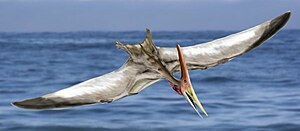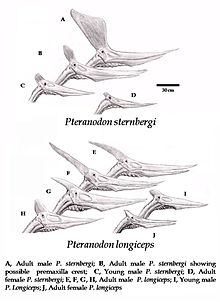Pteranodon
| Pteranodon | ||||||||||||
|---|---|---|---|---|---|---|---|---|---|---|---|---|

Pteranodon , life reconstruction |
||||||||||||
| Temporal occurrence | ||||||||||||
| Upper Cretaceous ( Santonium to Campanium ) | ||||||||||||
| 86.3 to 72 million years | ||||||||||||
| Locations | ||||||||||||
|
||||||||||||
| Systematics | ||||||||||||
|
||||||||||||
| Scientific name | ||||||||||||
| Pteranodon | ||||||||||||
| Marsh , 1876 | ||||||||||||
Pteranodon ( toothless wing of give a wiki .: πτερόν, πτεροῦ ( wing ) + ἀν (negation) + ὀδών (ὀδούς / -ών, ὀδόντος - tooth ) - without teeth ) was a great pterodactyloidea (Pterodactyloidea). Its fossil remains, a total of more than 1,000 finds, were found in chalk depositsin Kansas , Alabama , Nebraska , Wyoming and South Dakota . At that time, a large shallow sea, the Western Interior Seaway, stretched across North America from north to south. Along with Pteranodon , fossils of sea turtles , mosasaurs and early birds were found .
Like many pterosaurs, it fed on fish. Bones have been found in the fossilized stomach contents of a pteranodon . Because of their size, they are often compared to the albatrosses and it is believed that they used the sea breezes to glide like them.
features
The animals reached a wingspan of seven meters, with the largest representative Pteranodon sternbergi it was even nine meters. Only a few pterosaurs from the Azhdarchidae group , such as Quetzalcoatlus and Hatzegopteryx, were even larger. Unlike earlier pterosaurs like Rhamphorhynchus and Pterodactylus , Pteranodon - like modern birds - had a toothless beak, the upper part of which was formed from the fused premaxillaries and maxillaries . The two branches of the lower jaw had grown together in a long symphysis , the lower jaw had a keel on the underside. The infratemporal window (lower skull window of the temporal region) was small and slit-shaped, the eye openings small and situated high on the skull.
Many specimens of Pteranodon had a long occipital ridge. Much has been speculated about what it might serve. Among other things, it was suggested that it acted as a counterweight to the beak and was important for flight stability when fishing, or that it was used to insert powerful jaw muscles or to communicate with conspecifics. Christopher Bennett assumes that it was a sexual trait and the animals with larger crests were the males.
The cervical spine was relatively short but strong. Like all bones in the animal, the vertebrae were thin-walled, pneumatized and connected to the lungs via air holes on the sides. The first eight vertebrae were fused together to form a bone rod (Notarium). Their ribs were connected by longitudinal ridges and fused with the transverse processes. The ten sacral vertebrae formed a low plate with their spinous processes.
Systematics

Pteranodon is the type genus of the family Pteranodontidae, to which only the genus Ornithostoma , known only from a few bone fragments, belongs. Another form is the Tethydraco described in 2018 from the Ouled Abdoun Basin in Morocco . Some scientists also count the toothless Nyctosaurus to the Pteranodontidae. Together with the strongly toothed Ornithocheiridae , also glider pilots who glided over the seas and fed on fish, and the possibly scavenging Istiodactylus , the Pteranodontidae form the superfamily Ornithocheiroidea, one of the four great evolutionary lines of the short-tailed pterosaur.
species
- Pteranodon longiceps
- Pteranodon ingens
- Pteranodon sternbergi
literature
- David M. Unwin: The Pterosaurs. From deep time. PI Press, New York NY 2006, ISBN 0-13-146308-X .
- Peter Wellnhofer : The illustrated encyclopedia of pterosaurs. Crescent Books, New York NY 1991, ISBN 0-517-03701-7 .
- Peter Wellnhofer: Pterosaurs. Pterosauria. (= The new Brehm library. Volume 534). A. Ziemsen Verlag, Wittenberg Lutherstadt 1980, ISSN 0138-1423 .
Individual evidence
- ↑ S. Christopher Bennett: Sexual dimorphism of Pteranodon and other pterosaurs, with comments on cranial crests. In: Journal of Vertebrate Paleontology. Vol. 12, No. 4, 1992, ISSN 0272-4634 , pp. 422-434, doi : 10.1080 / 02724634.1992.10011472 .
- ↑ Nicholas R. Longrich, David M. Martill and Brian Andres: Late Maastrichtian pterosaurs from North Africa and mass extinction of Pterosauria at the Cretaceous-Paleogene boundary. In: PLoS Biology. Vol. 16, No. 3, 2018, p. E2001663, doi: 10.1371 / journal.pbio.2001663
